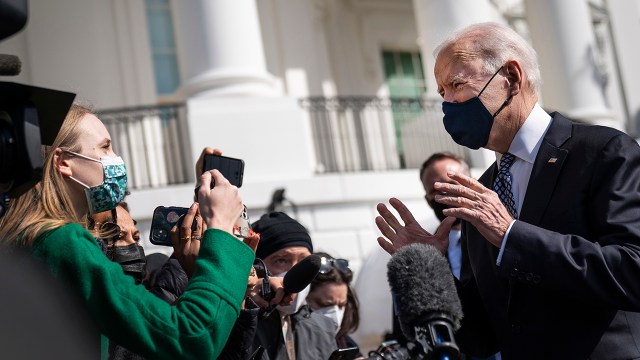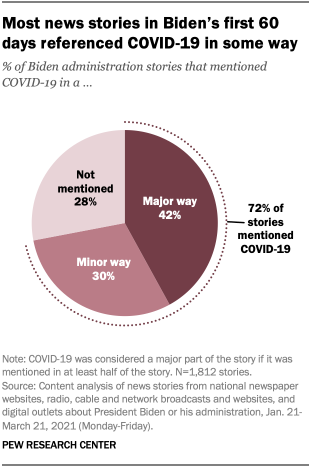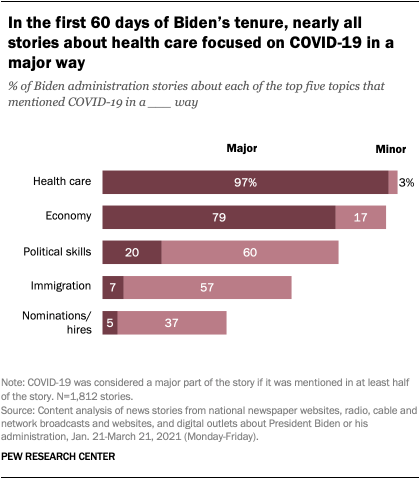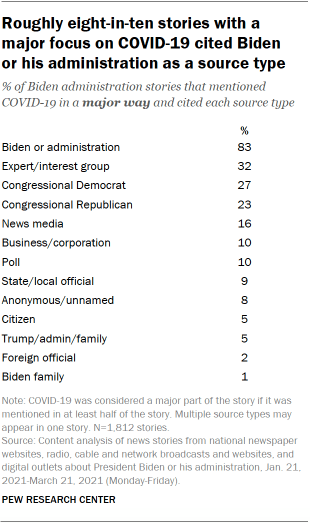
As the battle against the coronavirus outbreak was emerging as a defining issue in President Joe Biden’s young administration, the pandemic and its effects on society became a pervasive part of the media narrative about his first 60 days in office.
Indeed, nearly three-quarters of all news stories about the Biden administration’s early days in office (72%) mentioned COVID-19 in some way, according to a recent Pew Research Center report. It was a major part of the reporting – meaning at least half the story focused on it – in 42% of all stories about the administration and a minor part of the reporting in another 30%.
The presence of COVID-19 in these stories cut across a wide range of distinct topic areas. Not surprisingly, virtually every health care story analyzed included the coronavirus in some way, with 97% featuring it as a major element of the reporting. The vast majority of stories about the economy (96%) also mentioned the virus, with 79% focusing on it in a major way.
This analysis of news coverage of COVID-19 in the early days of Joe Biden’s presidency builds on an April 2021 Pew Research Center report, which examined the media’s broader coverage of the new administration, as well as Americans’ perceptions of that coverage.
The analysis of media content in this study is based on a selection of weekday media coverage collected from Jan. 21 to March 21, 2021. Stories were collected from television, radio, digital and print outlets and coded by a team of nine coders trained specifically for this project.
Part of this analysis examines the extent to which COVID-19 was mentioned in each news story evaluated. This captures whether COVID-19 was a major part of the story (focused on in at least 50% of the story), a minor part of the story (at least one mention, but not focused on in at least 50% of the story) or not a part of the story.
For the survey component of this analysis, we surveyed 12,045 U.S. adults from March 8 to 14, 2021. Everyone who completed the survey is a member of the Center’s American Trends Panel (ATP), an online survey panel that is recruited through national, random sampling of residential addresses. This way nearly all U.S. adults have a chance of selection. The survey is weighted to be representative of the U.S. adult population by gender, race, ethnicity, partisan affiliation, education and other categories. Read more about the ATP’s methodology here.
Here are the questions used for this report, along with responses, and its methodology.
This is the latest post in Pew Research Center’s ongoing investigation of the state of news, information and journalism in the digital age, a research program funded by The Pew Charitable Trusts, with generous support from the John S. and James L. Knight Foundation.
COVID-19 was an element in 80% of stories about Biden’s political skills and management and 64% of immigration stories, although on those two topics, it most often appeared in a minor way.
Despite the overall magnitude of COVID-19 coverage, there were some differences depending on the type of audience each outlet has. Outlets with right-leaning audiences were less likely to mention COVID-19 in a major way (29%) than outlets with left-leaning (45%) or mixed audiences (44%). Still, a majority of stories from all three outlet groups had at least some reference to the coronavirus. (Learn more about how Pew Research Center classified news outlet audiences by visiting Appendix A of the methodology of our recent study.)
Stories that had a major focus on COVID-19 were about as likely to carry positive as negative assessments of the Biden administration (26% vs. 25%), while nearly half (49%) had neither positive nor negative assessments. Stories that focused on COVID-19 in a minor way were more likely to put forth negative than positive assessments of the administration (36% vs. 22%), with 42% having neither a positive nor a negative assessment.
Among the stories that focused primarily on COVID-19, Biden or a member of his administration appeared as sources far more frequently than any other source type included in the study. Roughly eight-in-ten stories (83%) that mentioned COVID-19 in a major way cited the Biden administration (including statements and data from the Centers for Disease Control and Prevention). Statements from experts and interest groups, such as medical professionals and health organizations, were the second most prominent source types, cited in about a third of the COVID-19 stories (32%). Political figures, including Democrats and Republicans in Congress, appeared as sources in roughly a quarter of stories that focused on COVID-19 in a major way (27% and 23%, respectively).
Another sign of the pervasiveness of COVID-19 in news coverage of the first 60 days of the Biden presidency is the public’s awareness of the administration’s efforts and initiatives related to the pandemic. In a survey administered from March 8 to 14, about three-quarters of U.S. adults (77%) said they had heard a lot about the administration’s $1.9 trillion stimulus package. Almost the same percentage of adults (74%) said they had heard a lot about the administration’s efforts to distribute COVID-19 vaccines.
Note: Here are the questions used for this report, along with responses, and its methodology.




